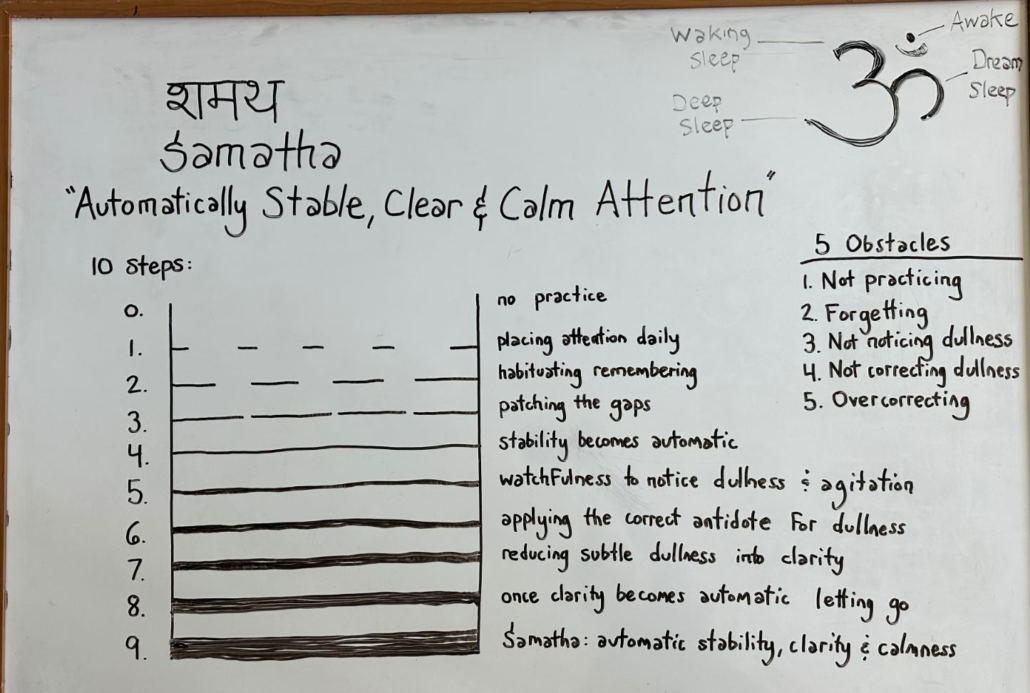Meditating with Sleep and Sleepiness
Have you found yourself nodding off during meditation?
Dullness or sleepiness are inherent experiences – experience, acknowledge but not to get caught in. Habit formed in long time members…with awareness, can be shifted – know the obstacles and the 9 stages of medication… from effort to effortless – from intention and attention and concentration to witnessing awareness.
Meditating with Sleep and Sleepiness with Mingyur Rinpoche
Heaviness of body and dullness of mind which can drag one down into inertia and depression is considered one of the five hindrances to Shamatha meditation. Any problem which arises in meditation will be one of these five hindrances, or a combination.
Ajahn Brahmasovo
The Five Hindrances
Venerable Ajahn Brahm says that the Five Hindrances are the only hindrances between us and awakening.
- Sense Desire (people or things we like)
- Ill will (people or things we don’t like)
- Sloth or Torpor (sloth refers to sleepiness and torpor refers to mentaldullness)
- Restlessness, anxiety or worry.
- Doubt. This word “doubt” is better understood when we read the Buddha’s explanation of “doubt.” He said a traveler lost in a desert with no map and no signposts is filled with doubt, not knowing which way is the way to safety. So doubt is essentially uncertainty, not knowing what to do.
Hindrances one and two are opposites. We run toward what we like and away from what we don’t. The middle way is to walk down the middle, not chasing sense desires and not running away from everything else.
Hindrances three and four are closely related. Hindrance three arises from too little energy and hindrance four arises from too much. We can’t be so dull that we lose our attentiveness (and mindfulness is attentiveness) but we can’t be racing with hyper mental activity. The middle way is to pay attention but without ego-identification.
That means when a knee starts hurting, instead of thinking “Oh, this is just great. Now my knee is hurting,” instead we note that the knee is hurting, note that it’s just another passing phenomenon, and go back to the practice. We don’t try to ignore or fight the pain, we just accept if with loving kindness as an old friend and return to the practice.
The 9 Stages of Meditation (Shamatha practice)
https://zenawakened.com/the-stages-of-meditation-shamatha/
The nine stages of meditation are like a roadmap as we venture forth into unknown territory.
These nine stages give us a fantastic framework in regards to understanding our progression as we go deeper into our meditative practice.
Below you’ll find the stages of meditation per the Shamatha tradition, mapped out for you.
Check them out and use them to help you explore the amazing world that meditation can open up for you.
They’ve been tested by thousands upon thousands of yogi for the last 2000+ years.
PHASE 1: The Flow of Involuntary Thoughts Are Like A Cascading Waterfall
1) Learning the Instructions & Placement of the Mind (Directed Attention)
2) Continuous Attention
3) Repeated Attention
PHASE 2: The Flow of Thoughts Are Like A River Quickly Flowing Through a Gorge
4) Close Attention
PHASE 3: The Flow of Thoughts Are Like A River Slowly Flowing Through A Valley
6) Pacified Attention
7) Fully Pacified Attention
PHASE 4: The Mind Is Calm Like an Ocean Unmoved by Waves
8) Single-Pointed Attention
In this stage the practitioner can reach high levels of concentration with only a slight effort and without being interrupted even by subtle laxity or excitement during the entire meditation session.
PHASE 5: The Mind Is Perfectly Still
9) Attentional Balance
The meditator now effortlessly reaches absorbed concentration and can maintain it for about four hours without any single interruption.
Full Achievement of Meditation or Shamatha


